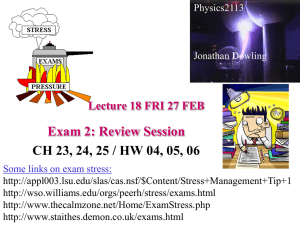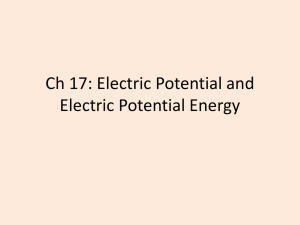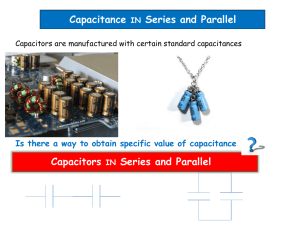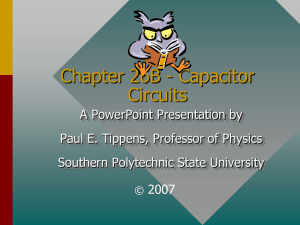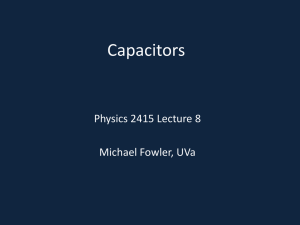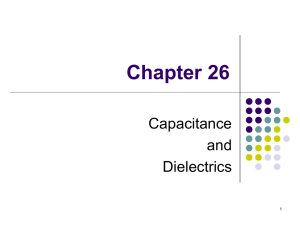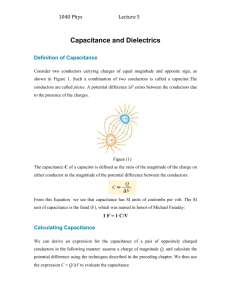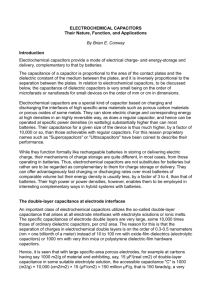Capacitance: Capacitors, Parallel Plates, Cylindrical & Spherical
advertisement
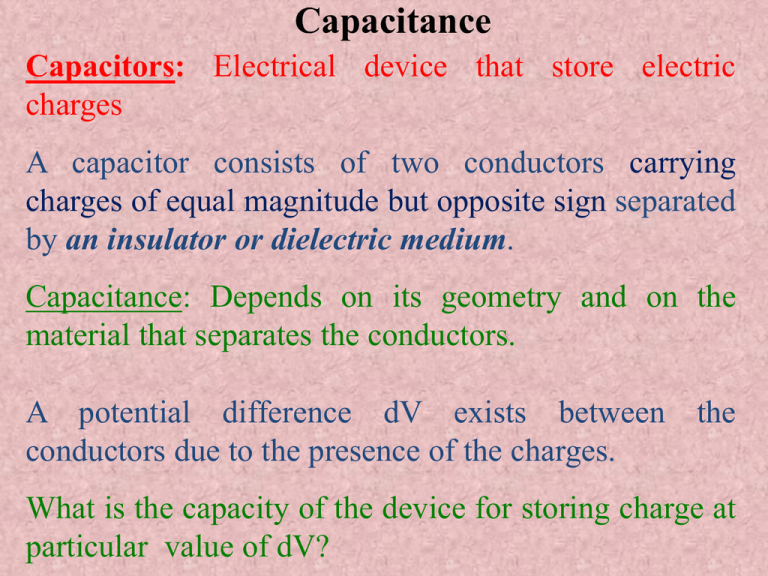
Capacitance Capacitors: Electrical device that store electric charges A capacitor consists of two conductors carrying charges of equal magnitude but opposite sign separated by an insulator or dielectric medium. Capacitance: Depends on its geometry and on the material that separates the conductors. A potential difference dV exists between the conductors due to the presence of the charges. What is the capacity of the device for storing charge at particular value of dV? Capacitance Experiments show the quantity of electric charge Q on a capacitor is linearly proportional to the potential difference between the conductors, that is Q V. Or we write Q = C V The capacitance C of a capacitor is the ratio of the magnitude of the charge on either conductor to the magnitude of the potential difference between them: C Q V SI Unit: farad (F), 1F = 1 C/V Typical device have capacitances ranging from microfarad to picofarad. Parallel - Plate Capacitors A parallel-plate capacitor consists of two parallel conducting plates, each of area A, separated by a distance d. When the capacitor is charged, the plates carry equal amounts of charge. One plate carries positive charge, and the other carries negative charge. The plates are charged by connection to a battery. Let two parallel metallic plates of equal area A separated by a distance d as shown. One plate carries a charge Q and the other carries a charge –Q. And surface charge density of each plate is s = Q/A. d A Variation with A If plates are large, then charges can distribute themselves over a substantial area, and the amount of charge that can be stored on a plate for a given potential diff increases as ‘A’ is increased. Thus we expect ‘C’ to be proportional to ‘A’. C A Variation with d: d Potential difference V constant across the plates, E field increases as d decreases. V Ed Imagine d decreases and consider situation before any charges have had a chance to move in response to this change. Because no charge move E the same over a shorter distance. V = Ed means that V decreases. A The difference between this new capacitor voltage and the terminal voltage of the battery now exists as a potential difference across the wires connecting the battery to the capacitor. A E field result in the wires that drives more charge onto the plates, increasing the potential diff. V until it matches that of the battery. potential diff. across wire = 0 flow of charges stop. d A More charges has accumulated at the capacitor as a result. We have d decrease, Q increases. Similarly d increases Q decreases. Capacitance inversely proportional to d. C 1/d The electric field between the plates of a parallel-plate capacitor is uniform near the center but nonuniform near the edges. Formula of capacitance for a Parallel-Plate Capacitors Assume electric field uniform between the plates, (from Gauss’s Law): E 0 Q 0A V Ed C Q V C Q 0A d Q Qd / 0 A 0A d What is a lightning discharge ? Friction forces between the air molecules within a cloud result in positively charged molecules moving to the lower surface, and the negative charges moving to the upper surface . The lower surface induces a high concentration of negative charges in the earth beneath. The resultant electric field is very strong, containing large amounts of charge and energy. If the electric field is greater than breakdown strength of air, a lightning discharge occurs, in which air molecules are ripped apart, forming a conducting path between the cloud and the earth. Cylindrical Capacitors L A solid cylindrical conductor of radius a and charge Q is coaxial with a cylindrical shell of negligible thickness, radius b > a, and charge –Q. If we assume an ideal cylindrical capacitor: •The electric field points radially from the inner cylinder to the outer cylinder. •The electric field is zero outside the collinear cylinders. Assume that L is >> a and b, neglect the end effects. E is perpendicular to the long axis of the cylinders and is confined to the region between them. L Potential difference between the two cylinders is given by b V b V a E .dl Where E is the field in the region a < r < b. a Our discussion on Gauss’s Law E = 2k/r = 2kQ/rL where is the linear charge density of the cylinder. Note that the charge on outer cylinder does not contribute to E field inside it. b V b V a 2kQ / rL.dl a 2kQ L C Q V L b 1 / r.d l a L b 2kln a What is the capacitance per unit length ? Q. Co-axial Cable. Read the cable, typically 50 pF/m. Is this sensible ? Typically a 0.5 mm, b 1.5 mm C/L 1 2 8 . 99 10 ln( 3 ) 9 50pF/m The Spherical Capacitors A spherical capacitor consists of a spherical conducting shell of radius b and charge –Q concentric with a smaller conducting sphere of radius a and charge Q. Find the capacitance of this device. Gauss’s law E field outside a spherically symmetric charge distribution is radial and given by Er = kQ/r2. The potential difference between the spheres is b b V b V a E .dr kQ a a C Q Vb V a 1 1 kQ a b dr r 2 ab k (b a ) Capacitance of an isolated sphere Q. Calculate the capacitance of an isolated spherical conductor of radius R and charge Q by assuming that the second conductor making up the capacitor is a concentric hollow sphere of infinite radius. Q Ans. Electric potential of the sphere of radius R is kQ/R and V= 0 at infinity, we have C Q V Q kQ / R R k 4 0 R C is proportional to its radius and independent of both the charge on the sphere and the potential difference. Capacitors in Circuits • Capacitors can be wired together in circuits in parallel or series – Capacitors in circuits connected by wires such that the positively charged plates are connected together and the negatively charged plates are connected together, are connected in parallel. – Capacitors wired together such that the positively charged plate of one capacitor is connected to the negatively charged plate of the next capacitor are connected in series. Capacitors in Parallel Consider an electrical circuit with three capacitors wired in parallel • Each of three capacitors has one plate connected to the positive terminal of a battery with voltage V and one plate connected to the negative terminal. .. key point for capacitors in parallel • potential difference V across each capacitor is the same. • We can write the charge on each capacitor as q1 C1V , q 2 C 2V , q 3 C 3V q q1 q 2 q 3 C 1V C 2 V C 3V C 1 C 2 C 3 V We can consider the three capacitors as one equivalent capacitor Ceq that holds a total charge q given by q C eq V C eq C 1 C 2 C 3 n A general result for n capacitors in parallel is: C eq C i i 1 Conclusion: If we can identify capacitors in a circuit that are wired in parallel, we can replace them with an equivalent capacitance. Capacitors in Series key point for capacitors in series: The battery produces an equal charge q on each capacitor because the battery induces a positive charge on the positive place of C1, which induces a negative charge on the opposite plate of C1, which induces a positive charge on C2, etc. Knowing that the charge is the same on all three capacitors we can write 1 1 1 V V1 V 2 V 3 q C1 C 2 C3 C 3 C1 C 2 q q q V q C eq We can express an equivalent capacitance Ceq as 1 C eq 1 C1 1 C2 1 C3 • We can generalize to n capacitors in series 1 C eq n 1 C i 1 i • If we can identify capacitors in a circuit that are wired in series, we can replace them with an equivalent capacitance.

